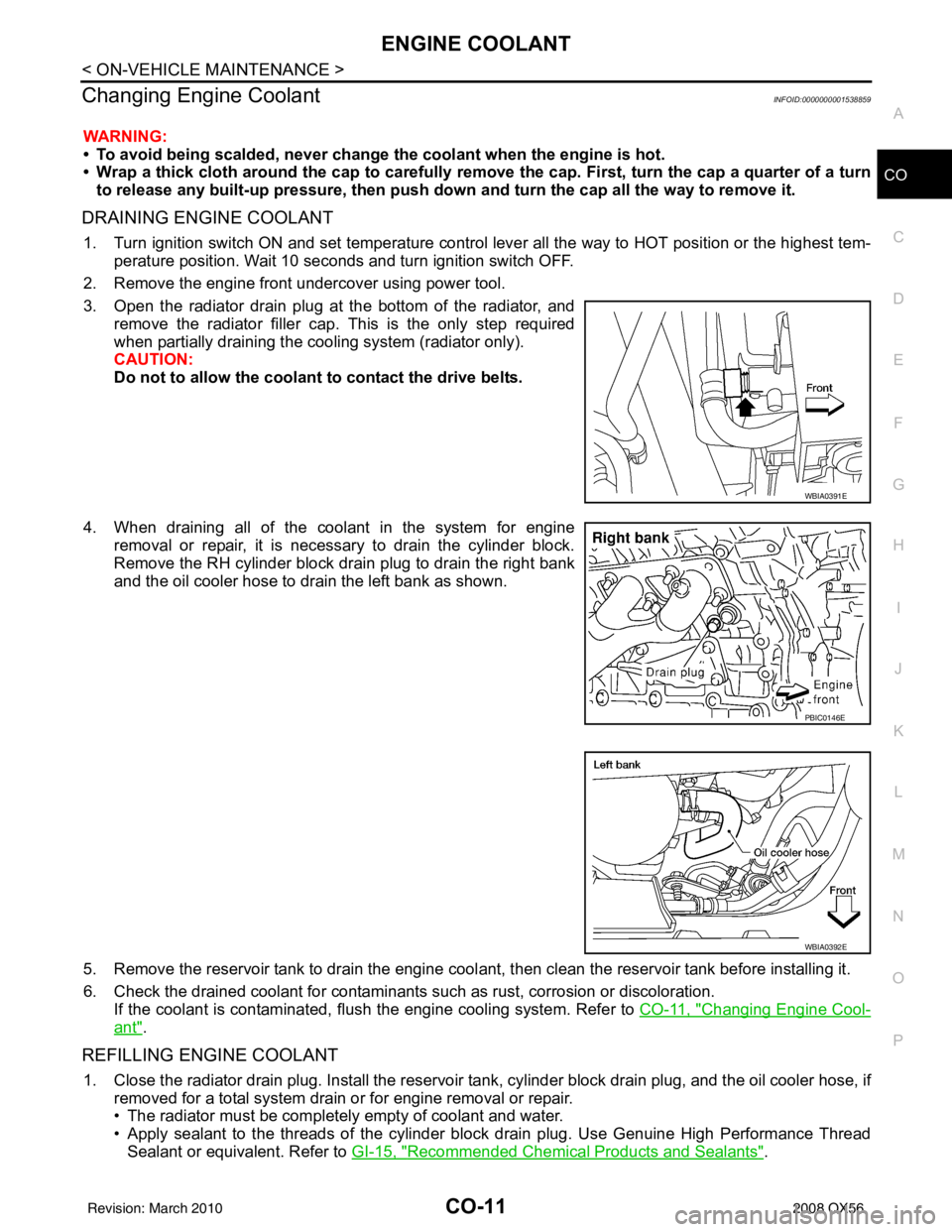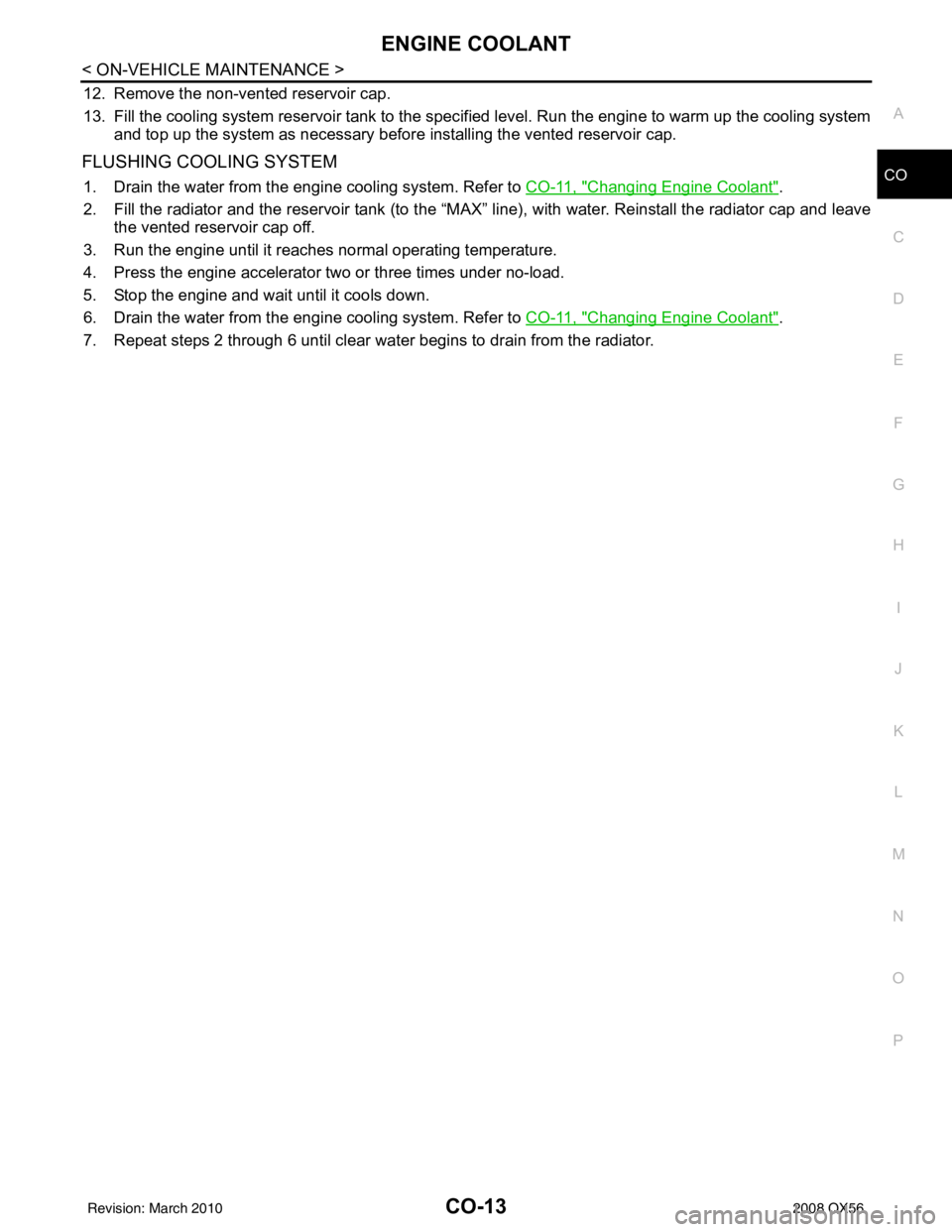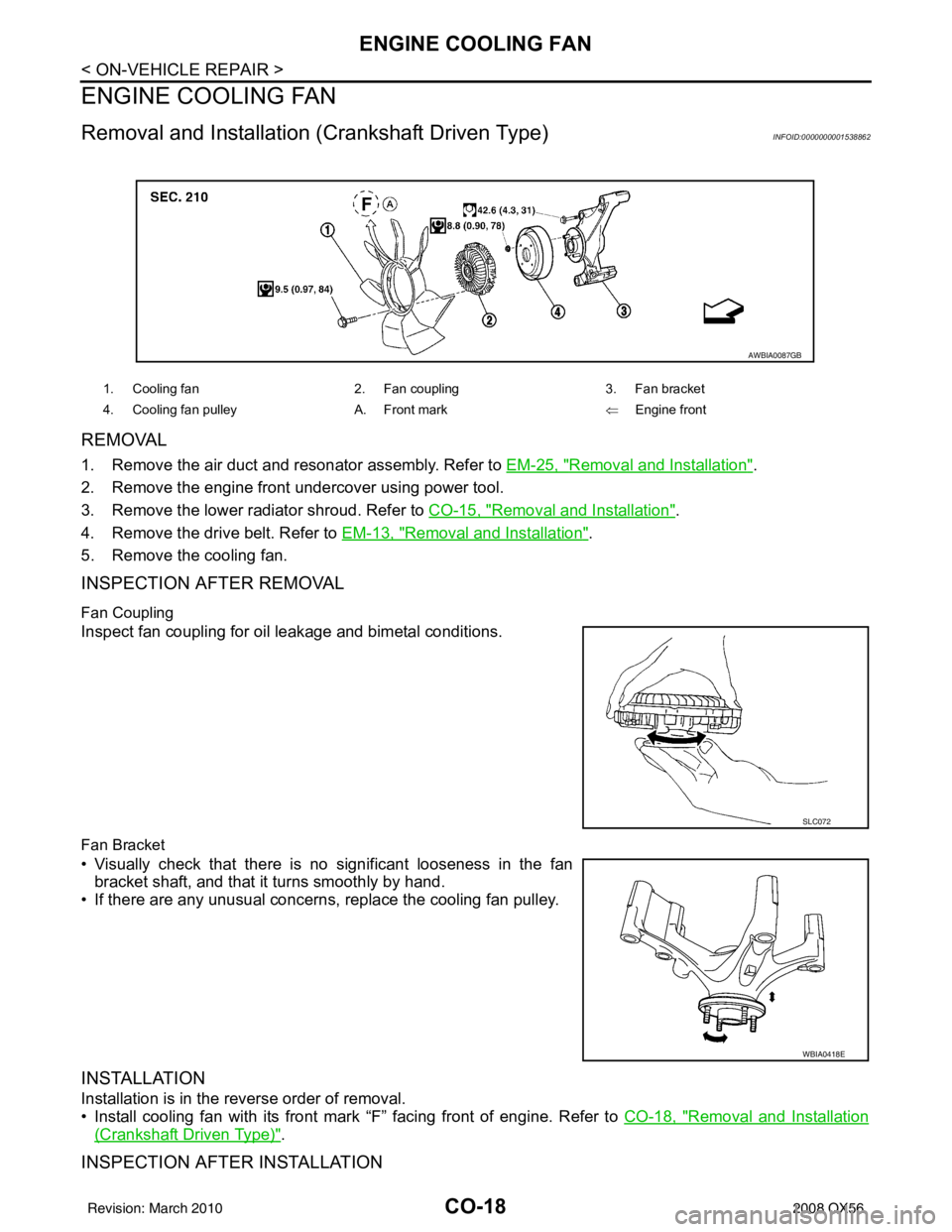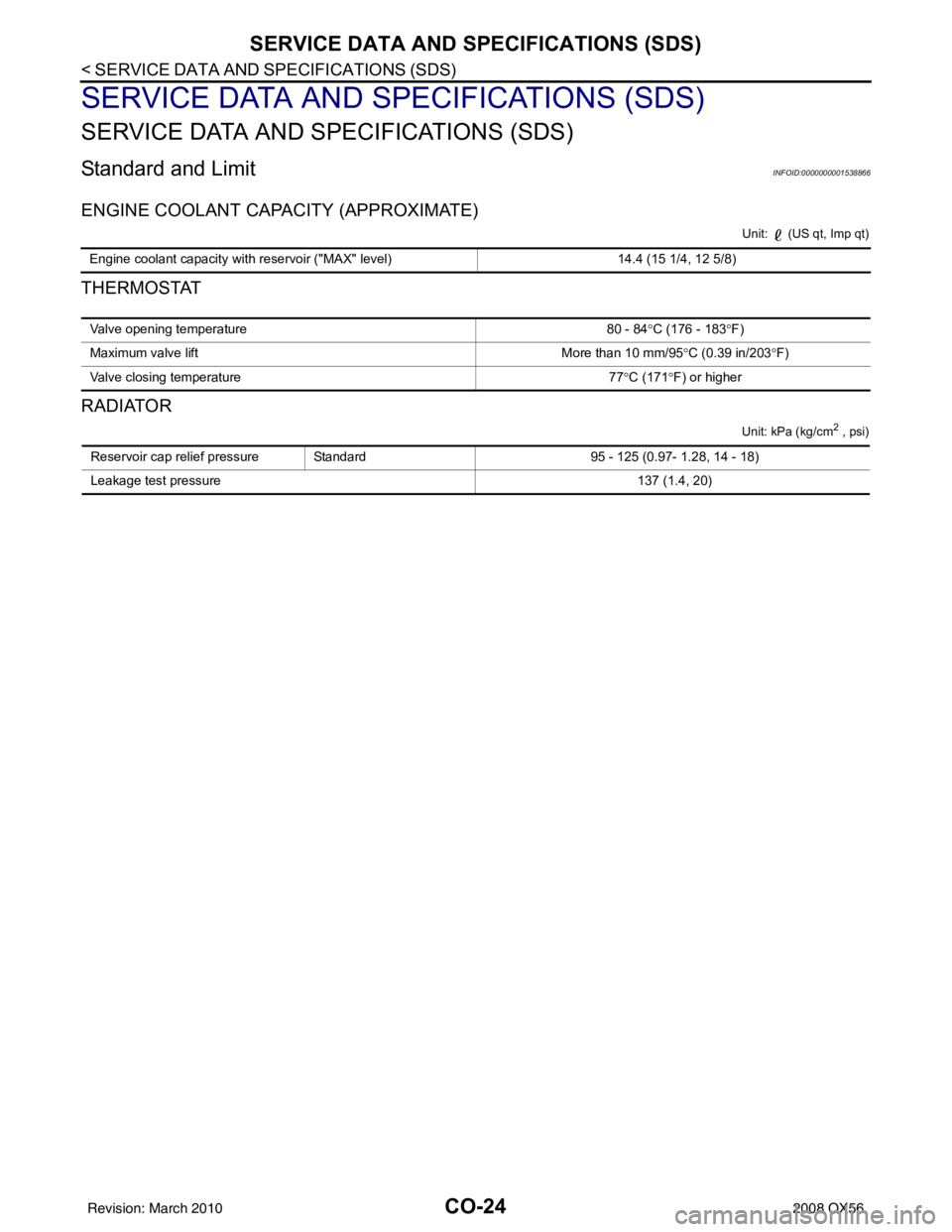radiator INFINITI QX56 2008 Factory User Guide
[x] Cancel search | Manufacturer: INFINITI, Model Year: 2008, Model line: QX56, Model: INFINITI QX56 2008Pages: 4083, PDF Size: 81.73 MB
Page 746 of 4083

ENGINE COOLANTCO-11
< ON-VEHICLE MAINTENANCE >
C
DE
F
G H
I
J
K L
M A
CO
NP
O
Changing Engine CoolantINFOID:0000000001538859
WARNING:
• To avoid being scalded, never change the coolant when the engine is hot.
• Wrap a thick cloth around the cap to carefully remo
ve the cap. First, turn the cap a quarter of a turn
to release any built-up pressure, then push down and turn the cap all the way to remove it.
DRAINING ENGINE COOLANT
1. Turn ignition switch ON and set temperature control lever all the way to HOT position or the highest tem-
perature position. Wait 10 seconds and turn ignition switch OFF.
2. Remove the engine front undercover using power tool.
3. Open the radiator drain plug at the bottom of the radiator, and remove the radiator filler cap. This is the only step required
when partially draining the cooling system (radiator only).
CAUTION:
Do not to allow the coolant to contact the drive belts.
4. When draining all of the coolant in the system for engine removal or repair, it is necessary to drain the cylinder block.
Remove the RH cylinder block drain plug to drain the right bank
and the oil cooler hose to drain the left bank as shown.
5. Remove the reservoir tank to drain the engine cool ant, then clean the reservoir tank before installing it.
6. Check the drained coolant for contaminants such as rust, corrosion or discoloration. If the coolant is contaminated, flush the engine cooling system. Refer to CO-11, "
Changing Engine Cool-
ant".
REFILLING ENGINE COOLANT
1. Close the radiator drain plug. Install the reservoir tank, cylinder block drain plug, and the oil cooler hose, if
removed for a total system drain or for engine removal or repair.
• The radiator must be complete ly empty of coolant and water.
• Apply sealant to the threads of the cylinder block drain plug. Use Genuine High Performance Thread Sealant or equivalent. Refer to GI-15, "
Recommended Chemical Products and Sealants".
WBIA0391E
PBIC0146E
WBIA0392E
Revision: March 2010 2008 QX56
Page 747 of 4083

CO-12
< ON-VEHICLE MAINTENANCE >
ENGINE COOLANT
2. Set the vehicle heater controls to the full HOT and heater ON position. Turn the vehicle ignition ON with
the engine OFF as necessary to activate the heater mode.
3. Remove the vented reservoir cap and replace it with a non-vented reservoir cap before filling the cooling
system.
4. Install the Tool by installing the radiator cap adapter onto the radiator neck opening. Then attach the gauge body assembly
with the refill tube and the venturi assembly to the radiator cap
adapter.
5. Insert the refill hose into the coolant mixture container that is placed at floor level. Make sure the ball valve is in the closed
position.
• Use Genuine NISSAN Long Life Anti-freeze coolant or equiva-lent, mixed 50/50 with distilled water or demineralized water.
Refer to MA-12, "
Fluids and Lubricants".
6. Install an air hose to the venturi assembly, the air pressure must be within specification.
CAUTION:
The compressed air supply must be equipped with an air
dryer.
7. The vacuum gauge will begin to rise and there will be an audible hissing noise. During this process open the ball valve on the refill hose slightly. Coolant will be vi sible rising in the refill hose. Once the refill hose is
full of coolant, close the ball valve. This will purge any air trapped in the refill hose.
8. Continue to draw the vacuum until the gauge reaches 28 inches of vacuum. The gauge may not reach 28 inches in high altitude
locations, use the vacuum specifications based on the altitude
above sea level.
9. When the vacuum gauge has reached the specifi ed amount, disconnect the air hose and wait 20 seconds
to see if the system loses any vacuum. If the vacuum level drops, perform any necessary repairs to the
system and repeat steps 6 - 8 to bring the vacuum to the specified amount. Recheck for any leaks.
10. Place the coolant container (with the refill hose insert ed) at the same level as the top of the radiator. Then
open the ball valve on the refill hose so the coolant will be drawn up to fill the cooling system. The cooling
system is full when the vacuum gauge reads zero.
CAUTION:
Do not allow the coolant container to get too low when filling, to avoid air from being drawn into
the cooling system.
11. Remove the Tool from the radiator neck opening and install the radiator cap. Radiator drain plug
: Refer to CO-11
.
RH cylinder block drain plug : Refer to EM-82
.
Tool number : KV991J0070 (J-45695)
Cooling system capacity
(with reservoir) : Refer to
MA-12, "
Fluids
and Lubricants".
Compressed air
supply pressure : 5.7 - 8.5 kPa (5.6 - 8.4 kg/cm
2, 80
- 120 psi)
LLIA0058E
Altitude above sea level Vacuum gauge reading
0 - 100 m (328 ft) : 28 inches of vacuum
300 m (984 ft) : 27 inches of vacuum
500 m (1,641 ft) : 26 inches of vacuum
1,000 m (3,281 ft) : 24 - 25 inches of vacuum
LLIA0057E
Revision: March 2010 2008 QX56
Page 748 of 4083

ENGINE COOLANTCO-13
< ON-VEHICLE MAINTENANCE >
C
DE
F
G H
I
J
K L
M A
CO
NP
O
12. Remove the non-vented reservoir cap.
13. Fill the cooling system reservoir tank to the specified level. Run the engine to warm up the cooling system
and top up the system as necessary befor e installing the vented reservoir cap.
FLUSHING COOLING SYSTEM
1. Drain the water from the engine cooling system. Refer to CO-11, "Changing Engine Coolant".
2. Fill the radiator and the reservoir tank (to the “MAX” line), with water. Reinstall the radiator cap and leave
the vented reservoir cap off.
3. Run the engine until it reaches normal operating temperature.
4. Press the engine accelerator two or three times under no-load.
5. Stop the engine and wait until it cools down.
6. Drain the water from the engine cooling system. Refer to CO-11, "
Changing Engine Coolant".
7. Repeat steps 2 through 6 until clear water begins to drain from the radiator.
Revision: March 2010 2008 QX56
Page 749 of 4083

CO-14
< ON-VEHICLE MAINTENANCE >
RADIATOR
RADIATOR
Checking RadiatorINFOID:0000000001538860
Check radiator for mud or clogging. If necessary, clean radiator as follows.
CAUTION:
• Be careful not to bend or damage the radiator fins.
• When radiator is cleaned without removal, remove all surrounding parts such as cooling fan, radia-tor shroud and horns. Then tape the harness and electrical connectors to prevent water from enter-
ing.
1. Apply water by hose to the back side of the radiator core vertically downward.
2. Apply water again to all radiator core surfaces.
3. Stop washing when dirt and debris no longer flow out from the radiator.
4. Blow air into the back side of radiator core vertically downward. • Use compressed air lower than 490 kPa (5 kg/cm
2, 71 psi) and keep distance more than 30 cm (11.8 in).
5. Blow air again into all the radiator core surfaces until no water sprays out.
Revision: March 2010 2008 QX56
Page 750 of 4083

RADIATORCO-15
< ON-VEHICLE REPAIR >
C
DE
F
G H
I
J
K L
M A
CO
NP
O
ON-VEHICLE REPAIR
RADIATOR
Removal and InstallationINFOID:0000000001538861
WARNING:
Never remove the radiator cap when the engine is hot.
Serious burns could occur from high-pressure
engine coolant escaping from the radiator.
REMOVAL
CAUTION:
Perform when the engine is cold.
1. Remove engine room cover. Refer to EM-24, "
Removal and Installation".
2. Drain engine coolant from the radiator. Refer to CO-11, "
Changing Engine Coolant".
3. Remove air cleaner and air duct assembly. Refer to EM-25, "
Removal and Installation".
4. Disconnect A/T fluid cooler hoses. • Install blind plug to avoid leakage of A/T fluid.
5. Disconnect radiator upper and lower hoses from radiator. CAUTION:
Do not allow coolant to contact drive belts.
WBIA0694E
1. Radiator 2. Bolt 3. Mounting rubber
4. A/T fluid cooler hose 5. Radiator hose (lower) 6. Flaps
7. Radiator shroud (upper) 8. Radiator shroud (lower) 9. Drain plug
10. Radiator hose (upper) 11. Reservoir tank hose 12. By-pass hose
13. Reservoir tank 14. Reservoir tank cap A. To radiator fill neck
B. To A/T cooler tube C. To water suction pipe D. To thermostat housing
Revision: March 2010 2008 QX56
Page 751 of 4083

CO-16
< ON-VEHICLE REPAIR >
RADIATOR
6. Remove the lower radiator shroud.• Release the tabs, pull lower radiator shroud rearwards anddown to remove.
7. Remove the radiator shroud upper bolts and remove the radiator shroud upper A.
8. Remove the A/C condenser bolts and brackets. NOTE:
Lift A/C condenser up and forward to remove from radiator.
9. Remove A/T oil cooler bolts and oil cooler from radiator and position aside.
WBIA0407E
WBIA0695E
WBIA0395E
WBIA0396E
Revision: March 2010 2008 QX56
Page 752 of 4083

RADIATORCO-17
< ON-VEHICLE REPAIR >
C
DE
F
G H
I
J
K L
M A
CO
NP
O
10. Lift up and remove the radiator.
CAUTION:
Do not damage or scratch air conditioner condenser and
radiator core when removing.
INSTALLATION
Installation is in the reverse order of removal.
INSPECTION AFTER INSTALLATION
• Check for leaks of engine coolant. Refer to CO-10, "Inspection".
• Start and warm up the engine. Visually check for leaks of the engine coolant and A/T fluid.
PBIC1536E
Revision: March 2010 2008 QX56
Page 753 of 4083

CO-18
< ON-VEHICLE REPAIR >
ENGINE COOLING FAN
ENGINE COOLING FAN
Removal and Installation (Crankshaft Driven Type)INFOID:0000000001538862
REMOVAL
1. Remove the air duct and resonator assembly. Refer to EM-25, "Removal and Installation".
2. Remove the engine front undercover using power tool.
3. Remove the lower radiator shroud. Refer to CO-15, "
Removal and Installation".
4. Remove the drive belt. Refer to EM-13, "
Removal and Installation".
5. Remove the cooling fan.
INSPECTION AFTER REMOVAL
Fan Coupling
Inspect fan coupling for oil leakage and bimetal conditions.
Fan Bracket
• Visually check that there is no significant looseness in the fan bracket shaft, and that it turns smoothly by hand.
• If there are any unusual concerns, replace the cooling fan pulley.
INSTALLATION
Installation is in the reverse order of removal.
• Install cooling fan with its front mark “F” facing front of engine. Refer to CO-18, "
Removal and Installation
(Crankshaft Driven Type)".
INSPECTION AFTER INSTALLATION
1. Cooling fan 2. Fan coupling3. Fan bracket
4. Cooling fan pulley A. Front mark ⇐Engine front
AWBIA0087GB
SLC072
WBIA0418E
Revision: March 2010 2008 QX56
Page 757 of 4083

CO-22
< ON-VEHICLE REPAIR >
THERMOSTAT AND WATER PIPING
THERMOSTAT AND WATER PIPING
Removal and InstallationINFOID:0000000001538865
REMOVAL
Removal of Thermostat
1. Drain engine coolant from the radiator. Refer to CO-11, "Changing Engine Coolant".
CAUTION:
Perform when engine is cold.
2. Remove the air duct and resonator assembly. Refer to EM-25, "
Removal and Installation".
3. Remove the engine room cover using power tools.
4. Disconnect the water suction hose from the water inlet.
5. Remove the water inlet and thermostat.
Removal of Thermostat Housing, Water Outlet and Heater Pipe
1. Remove the intake manifold. Refer to EM-26, "Removal and Installation".
2. Remove the thermostat housing, water outlet and heater pipe.
Removal of Water Cut Valve
1. Drain the engine coolant from the radiator. Refer to CO-11, "Changing Engine Coolant".
CAUTION:
Perform when the engine is cold.
2. Remove the air duct and resonator assembly. Refer to EM-25, "
Removal and Installation".
KBIA2501E
1. Heater pipe2. Gasket 3. Water outlet
4. Gasket 5. O-ring 6. O-ring
7. Thermostat housing 8. Rubber ring 9. Thermostat
10. Water inlet 11. Water suction hose 12. Water suction pipe
13. Gasket 14. Heater pipe
Revision: March 2010 2008 QX56
Page 759 of 4083

CO-24
< SERVICE DATA AND SPECIFICATIONS (SDS)
SERVICE DATA AND SPECIFICATIONS (SDS)
SERVICE DATA AND SPECIFICATIONS (SDS)
SERVICE DATA AND SPECIFICATIONS (SDS)
Standard and LimitINFOID:0000000001538866
ENGINE COOLANT CAPACITY (APPROXIMATE)
Unit: (US qt, Imp qt)
THERMOSTAT
RADIATOR
Unit: kPa (kg/cm2 , psi)
Engine coolant capacity with reservoir ("MAX" level)14.4 (15 1/4, 12 5/8)
Valve opening temperature80 - 84°C (176 - 183 °F)
Maximum valve lift More than 10 mm/95°C (0.39 in/203 °F)
Valve closing temperature 77°C (171 °F) or higher
Reservoir cap relief pressure Standard 95 - 125 (0.97- 1.28, 14 - 18)
Leakage test pressure 137 (1.4, 20)
Revision: March 2010 2008 QX56